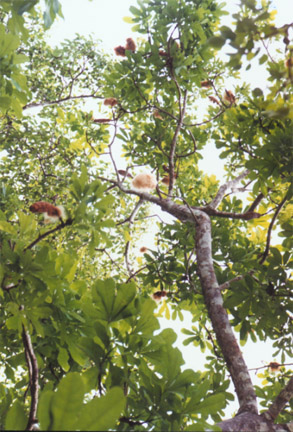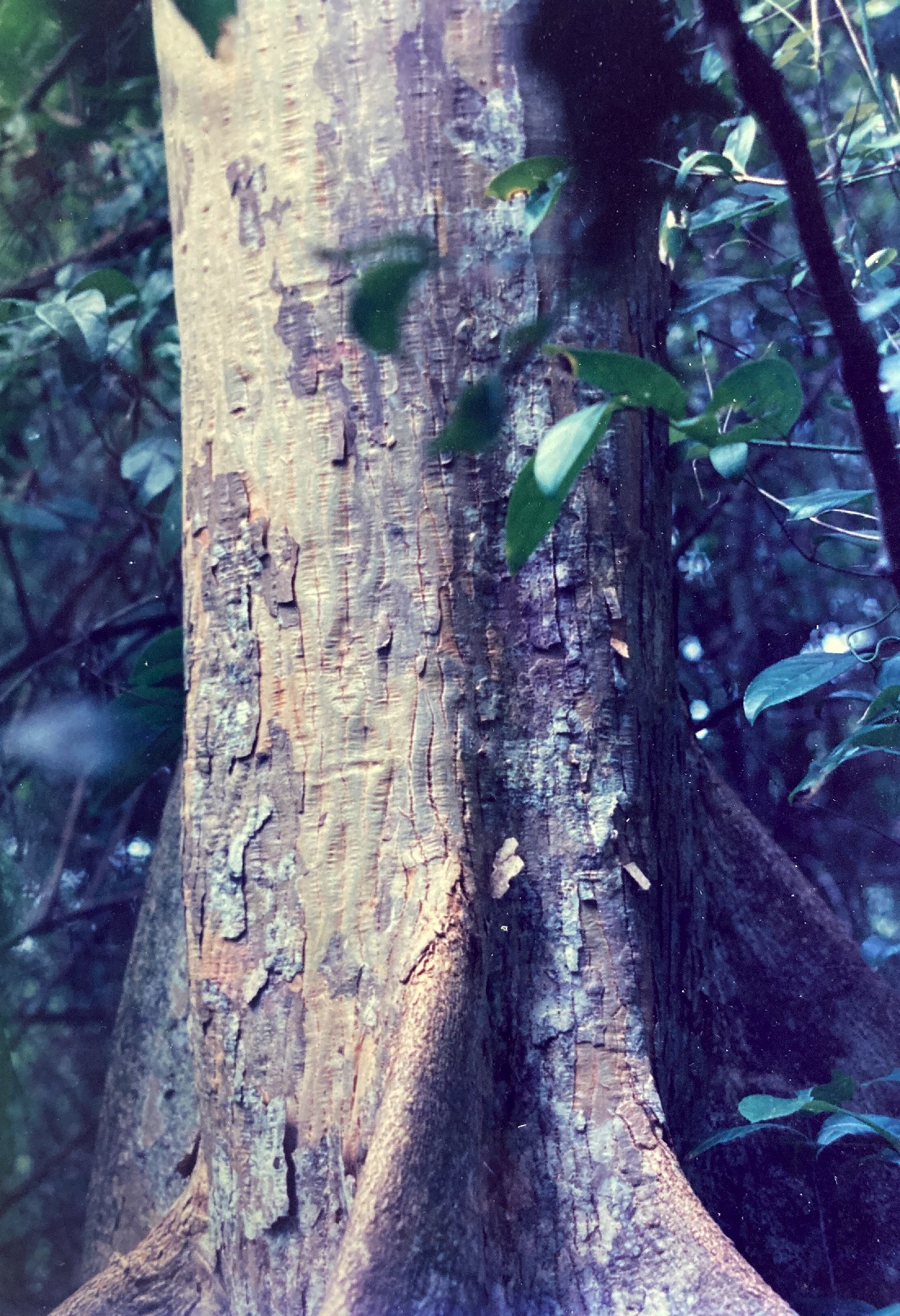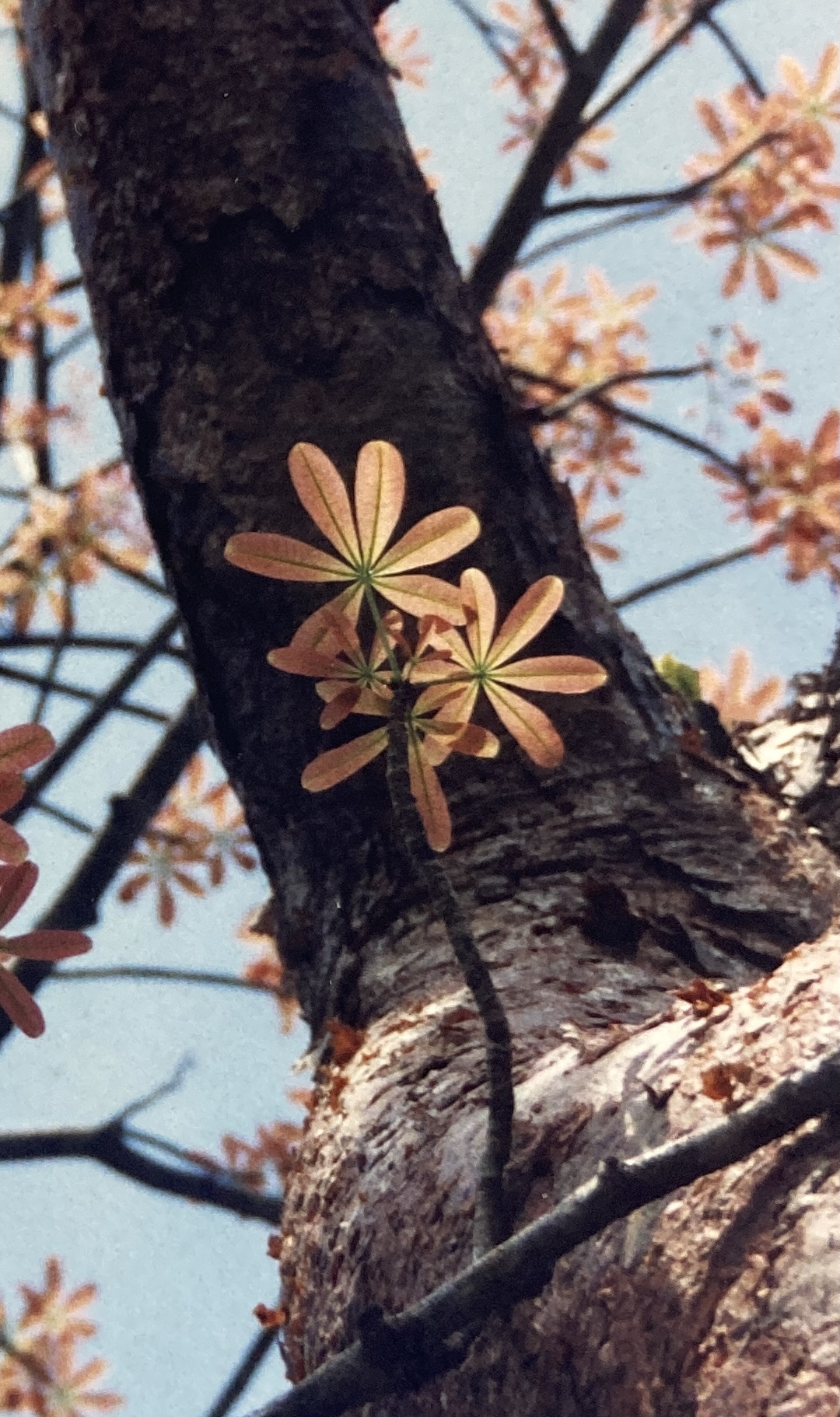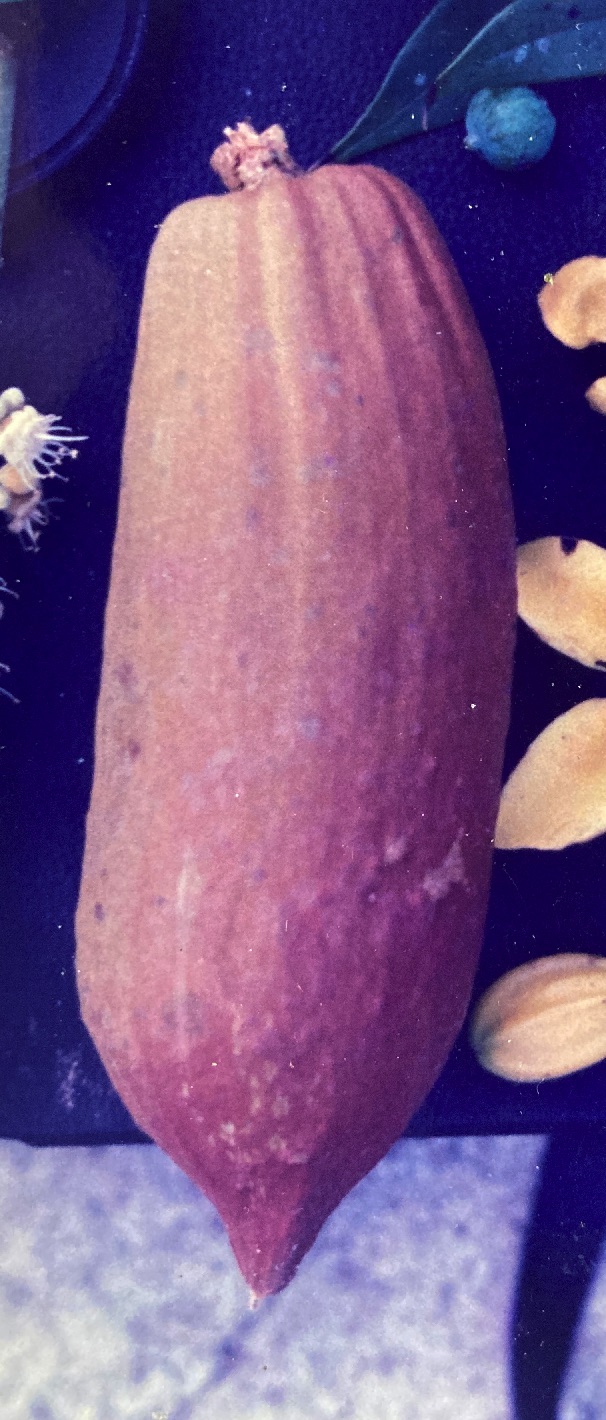Bombacopsis sessilis (Benth.) Pittier
Bombacaceae PALO VERDE, CEIBA
Tree: Rare deciduous canopy tree (20-25m) found growing almost exclusively in sandy soils and in near proximity to the ocean. Often forming small stands, Palo Verde is an interesting tree for its unique ecology, attractive leaves, and very limited range: it is endemic to Panama and Costa Rica’s southern Pacific coast.
Description: Palo Verde has a cylindrical, though bent and often inclined trunk (60 cm). At its base, the bole develops small but distinct buttress roots that meld with it at a height of about one meter. Branches are relatively few in number, stout, and haphazardly arranged, yielding a thin, somewhat narrow, asymmetrical crown. Palo Verde’s bark is green to yellow in color, with prominent and extended vertical cracking. Older bark turns gray and eventually exfoliates in narrow, thin strips.
The foliage is made up of palmately compound, alternate leaves (23 cm long), each bearing approximately seven or eight leaflets at the end of a long petiole (9 cm). Leaflets are spatulate (wider distally and slowly tapering proximally), with obcordate (indented) apices and smooth surfaces. They are arranged in a circle around their common point of attachment to the petiole, forming an almost complete, though asymmetrical, disk of leaf tissue. Of variable size, distally placed leaflets are about twice as big (11 cm by 4 cm) as proximal ones (6 cm by 3 cm). Old leaves senesce and are shed during December and the trees remain bare until late February when leaf buds break and new foliage begins to expand. Emerging like so many small stars, the new leaves surround twig tips in a single horizontal plane. Still thin, and translucent, sunlight filters through the blades, making them glow with different pastel shades of pink, orange, and green. The aesthetic harmony of color, form, and arrangement is quite stunning. Trees are fully foliated by May.
Palo Verde’s flowers are also unusual. They are produced at the ends of the stubby, bare twigs and are composed of five, long (15 cm), bicolored petals – divided longitudinally into green and maroon halves. These curl back around the base of the flower and expose an equally long bundle of about 200 white stamens surrounding a central red pistil. Opening at night, Palo Verde blossoms release a very sweet-smelling aroma. Flowers are present from mid-December through mid-February. When they die, the accumulation of brown, dried stamens and petals on otherwise leafless trees combine to give them a brownish cast – making Palo Verde boles recognizable from a distance (particularly when seen along the coast from the water).

Relatively few fruits develop from the many flowers that bloom. Each is a brown, leathery pod (17 cm long by 5 cm in diameter) containing tens of globular brown seeds (1 cm) embedded in copious quantities of tan-colored cotton. When the pod dries sufficiently, it opens and the outer husk falls to the ground, leaving the seeds and cotton exposed and still clinging to the branch. Over a period of days or weeks, the seeds are released – each with its own individual cottony “parachute” – as the wind tugs at and dislodges them. Harvests last from March to early June. Germination of the seeds is immediate upon contact with moist soil – or, if the weather is still dry, the arrival of the rainy season.
Similar Species: Palmately compound leaves are shared by many members of the Bombacaceae and Bignoniaceae families present in Manuel Antonio. Tabebuia – of the latter family – is easy to distinguish since its leaves are made up of only five leaflets (see description). Barrigón (Pseudobombax septenatum) and Ceiba (Ceiba pentandra), both of the Bombacaceae, have leaflets in similar numbers to those of Palo Verde. Barrigón has a greener trunk, and this coloration is broken into vertical stripes that Bombacopsis lacks. The Ceiba tree grows to immense, emergent proportions, and it is found in the deep forest – far away from the coast – which is the only place the smaller Palo Verde tree is found.
Natural History: As with most Bombacaceae flowers, those of Palo Verde are pollinated at night by bats and large moths, though bees can be observed visiting them in large numbers during the day. Bombacopsis seeds are wind dispersed. Their cottony parachutes cause them to fall more slowly, allowing them to be carried longer distances by air currents. Furthermore, once on the ground they act like small tumbleweeds, gaining extra distance by rolling across the smooth and sandy soil. The advantages inherent in dry season fruiting for a tree that depends upon cotton for creating air resistance and maintaining lightness are apparent.
Orange-chinned parakeets have been observed searching through the cottony pods while still in the trees and eating the seeds that they find. This parasitic behavior does not aid in seed dispersal since the seeds thus consumed are usually destroyed.
Bromeliads and other epiphytic plants are commonly found attached to Palo Verde branches due to the openness of its crown and the large amounts of insolation that penetrate it. This is even more true during the dry season when no foliage is present to obstruct the sun.
Palo Verde’s green bark probably enables it to continue doing photosynthesis during the dry season, when leaves are not present. It shares this characteristic with two other deciduous trees present in Manuel Antonio: Barrigón (Pseudobombax septenatum) and Indio Desnudo (Bursera simaruba).
Uses: Palo Verde’s seeds are edible (they are said to be especially good toasted). The cotton found in the pods can be used as insulation or as a filler for upholstery. As is the case with other Ceibas, Palo Verde wood is light and not used.
Distribution: In Manuel Antonio National Park, Palo Verde is only found within the fringe of vegetation lining the second beach (Playa Espadilla Sur). It is protected in Costa Rica by Manuel Antonio and Corcovado National Parks. Palo Verde ranges from southwestern Costa Rica to Panama.
Photos: Tree Trunk/Bark New Leaf New Leaf2 Flower Fruit



